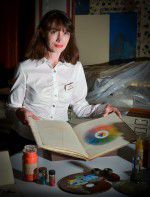Dr Alexandra Loske
Dr Alexandra Loske, Art Historian & Curator at the Royal Pavilion, tells us about her experience as a doctoral researcher and what happened next.
 What’s your background?
What’s your background?
I am a mature student and arrived from Germany 18 years ago with an MA in Linguistics and Literature. I had always led a double life in academia and the non-academic world. I was an antiquarian bookseller and a librarian here at the University of Sussex, and then embarked on another MA in Art History.
How did you end up doing a PhD?
Unexpectedly, I was awarded a scholarship for a PhD in 2007. I hadn’t necessarily considered a career change because that scholarship coincided with the birth of my daughter. I couldn’t really think how I was going to make it work. It was a collaborative scholarship, which means the researcher is based at the university, but also placed at a collection, museum, or historic building. In my case it was the Royal Pavilion. So immediately, I was involved in a non-academic environment. I had two supervisors, one at the university and one at the Pavilion. This meant I had an opportunity to pursue a non-academic route. It took me 6 years to complete my PhD on a part-time basis.
What’s your thesis about?
The subject of my thesis is probably boring to 99.9% of people. It is Regency colour theory. It sounds like something that you can’t apply to very much, but I was able to - it has also given me non-academic work. And the images from my research were actually projected onto the Royal Pavilion at the opening of an exhibition. Even the most obscure doctoral research might give you unexpected opportunities.
Did you do paid work alongside your research?
A lot of interesting work came out of my research. Having a young daughter, I didn’t want a full-time post; I needed freelance or part-time work. Throughout my research I was looking for opportunities. I did a lot of teaching, which I really enjoyed.
I’m also the Managing Editor of the Frogmore Press, a small publisher that has been running for 30 years. It was founded by my husband. He’s the creative head, while I deal with the artwork, communications and some of the editing. Of course, this isn’t paid. It’s our own private enterprise and it makes hardly any money. Most of the profits now go on postage. But it looks fantastic on my CV and it leads to other work. If I wanted to become an editor, this experience would help me. I enjoy it because it involves both literature and art.
During my research, I started working as a guide, giving tours of the Royal Pavilion. I became an expert and was given the most interesting groups. It’s non-academic work, but still very specialist and overlaps nicely with my research. I give gallery talks, too, which is paid work. From that came TV work, as I knew how to deal with different types of audiences - not just academics. There’s not a lot of money in that, but I do get asked to come back and have had the opportunity to work with Lucy Worsley, Michael Portillo, Fiona Bruce and others. Curating work is very good, but difficult to get. My first exhibition was unpaid and I was only given a little bit of support, but it was totally worth it. From that, I got my next job - a very small and difficult exhibition on the composer Frederick Delius. I was headhunted, and it was at the Royal Albert Hall, and it was well paid! I can now say that I’ve had an exhibition at the Royal Albert Hall, although it was only small. Make yourself available and do a good job. Do some things for free, then you can charge.
What are you doing now?
I still work at both the University of Sussex and the Royal Pavilion, where I am now working freelance on my fourth exhibition. Recently I was given a fellowship to visit St Petersburg and look at palaces and collections. There’s a possibility that this project will become an exhibition on Chinoiserie. I have also just been offered a part-time curator post at the Royal Pavilion, which is just what I had hoped for.
I give lots of talks, and it’s very useful to know how to gauge an audience. I have around 25 lectures that I can adapt quite easily for a range of audiences, such as the Women’s Institute, young people or scholars at academic conferences. You need to be open to engage with different groups. I also do translation work. It’s an unusual way of working, but it suits me.

